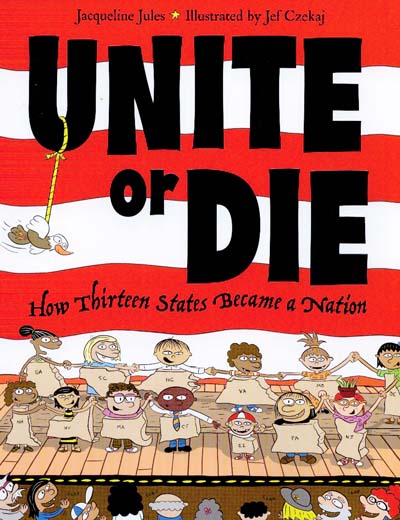Unite or Die: How Thirteen States Became a Nation
by Jacqueline Jules, illustrated by Jef Czekaj, Watertown, MA: Charlesbridge, 2009. (978-1-58089-189-9).
Author website: http://www.jacquelinejules.com
Illustrator website: http://www.czekaj.com
Media: Ink on Bristol and then scanned and colored on an Apple iBook using Adope Photoshop 6.0
Awards and Honors: 2010 Annual Whitney & Scott Cardozo Award for Children’s Literature;
Listed on New York Public Library Recommended Reading List, 2009.
Listed on New York Public Library Recommended Reading List, 2009.
Annotation: With a style described as reader’s theater, this book presents a dramatic reenactment of how and why the United States Constitution came to be with humor, energy, and personality.
Personal Reaction: The challenges the thirteen colonies faced after the American Revolution, particularly in the creation of the United States Constitution, are highlighted in this playful, entertaining story which showcases a group of elementary students performing a reenactment of the conflicts and compromises of the time: each performer represents a new state’s interests and concerns. Author Jacqueline Jules’ style appeals to students of all ages in that half of the story is told through traditional, narrative text while the other half is represented by the conversation bubbles of the students (in their own language). Illustrator Jef Czekaj’s cartoon drawings of the student’s performing their stage “state” roles enhances the text and brings the performance to life in a believable way. The pacing is quick as the reader jumps from conversation bubbles and different student’s arguments for their state’s cause while the bright, silly cartoons renew interest and relate to young readers in what can often be a stale, disconnected subject for students.
Jules begins the book with the end of the American Revolution, showing how the thirteen new states act independently of each other and the problems that arise because of this. When the states agree to work together for a solution (and a more united government), readers are met with an onslaught of new problems as to how much work goes into the creation of the Constitution—or rather, how many arguments and disagreements the states have for different solutions. By the time a final compromise is made and the U.S. Constitution is signed, readers will understand how and why America’s government was created to balance power between three branches.
An afterword provides a more “textbook” discussion of the creation of the Constitution and the following five pages of “Notes” reference specific pages in the book before highlighting important historical aspects that were presented in that section, such as “Who owned Vermont?” and “How did Roger Sherman save the day?” These references add further depth to the story itself and to the events that took place leading up to, and during, the creation of the U.S. Constitution. Jules also provides a lengthy bibliography that students can use for further reading and research.
The interactive style of this book comes from the idea of “reader theater,” where teaches can use their students as characters. The style of the book—where the characters are already putting on a play of their own—sets students up for successful adoption of this book for a live performance, truly bringing history to life and into the classroom. The cartoon art of Czekaj connects to the young reader’s interests and personal preference of media styles while Jules’ conversation bubbles move the story along in a relatable, engaging way. The narration text provides a foundation for the students’ performances and are written as clear, simple descriptions that set up the current page’s scene. Jules’ and Czekaj’s fun, pop-culture storytelling style make history appealing, not scary, to readers and provide a creative platform as for how students can learn about the creation of the U.S. Constitution.
Jules begins the book with the end of the American Revolution, showing how the thirteen new states act independently of each other and the problems that arise because of this. When the states agree to work together for a solution (and a more united government), readers are met with an onslaught of new problems as to how much work goes into the creation of the Constitution—or rather, how many arguments and disagreements the states have for different solutions. By the time a final compromise is made and the U.S. Constitution is signed, readers will understand how and why America’s government was created to balance power between three branches.
An afterword provides a more “textbook” discussion of the creation of the Constitution and the following five pages of “Notes” reference specific pages in the book before highlighting important historical aspects that were presented in that section, such as “Who owned Vermont?” and “How did Roger Sherman save the day?” These references add further depth to the story itself and to the events that took place leading up to, and during, the creation of the U.S. Constitution. Jules also provides a lengthy bibliography that students can use for further reading and research.
The interactive style of this book comes from the idea of “reader theater,” where teaches can use their students as characters. The style of the book—where the characters are already putting on a play of their own—sets students up for successful adoption of this book for a live performance, truly bringing history to life and into the classroom. The cartoon art of Czekaj connects to the young reader’s interests and personal preference of media styles while Jules’ conversation bubbles move the story along in a relatable, engaging way. The narration text provides a foundation for the students’ performances and are written as clear, simple descriptions that set up the current page’s scene. Jules’ and Czekaj’s fun, pop-culture storytelling style make history appealing, not scary, to readers and provide a creative platform as for how students can learn about the creation of the U.S. Constitution.
California History / Social Science, Grade 5, California Standard: 5.7: Students describe the people and events involved in the development of the U.S. Constitution and the impact and consequences of the document for the new nation.

No comments:
Post a Comment